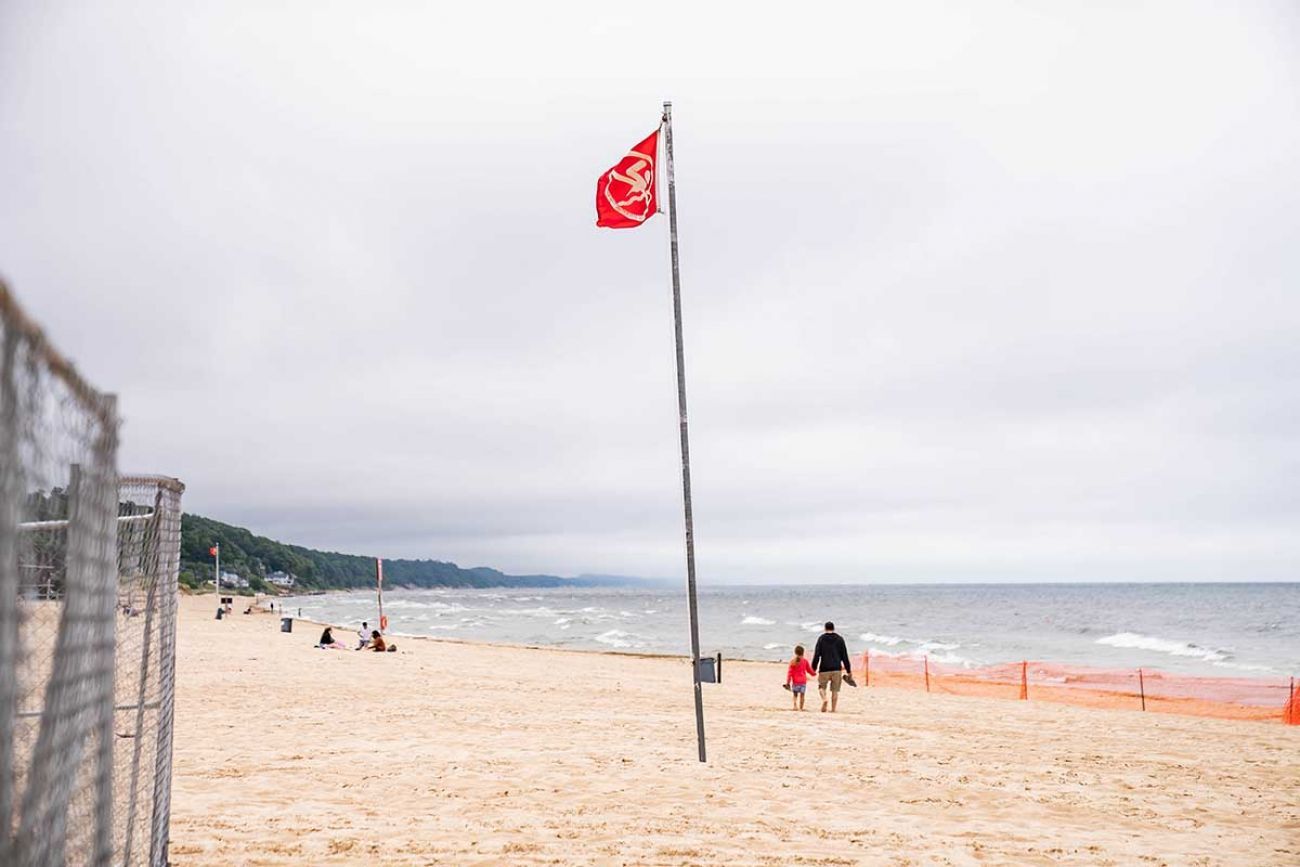Drownings are up across the Great Lakes. Michigan officials urge water safety

There have been 47 drownings so far in the Great Lakes this year, 20 of which occurred in Lake Michigan. That’s already up 38 percent from last year when there were 34 drownings reported through Independence Day.
And though only a handful of the Great Lakes drownings so far this year have been at Michigan beaches, the Independence Day weekend has historically been a busy one for the state’s shorelines, and a bad one for drownings.
Related:
- People ignore drowning warnings, so Michigan may close Great Lakes beaches
- Great Lakes water levels could increase on average from 7.5 to 17 inches in next few decades, study says
- Great Lakes surfers to Michigan: Don’t close beaches during rough waves
“Last year we had 100 Great Lakes drownings and at this pace we’ll surpass that this year,” Dave Benjamin, the co-founder and executive director of the Great Lakes Surf Rescue Project said. “Every week these numbers are going up and sometimes you get multiple drownings in a day.”
According to data collected by the water safety-focused nonprofit, only two of the reported drownings in 2022 have taken place on Michigan shores — a pair of teenage brothers drowned in Lake Michigan while visiting Warren Dunes State Park, located in Sawyer, in May. Two other teens were rescued from the lake and survived.
There have been other close calls at Michigan beaches since then, so it’s important to take precautionary measures when going for a dip in the Great Lakes this weekend, Ron Olson, chief of parks and recreation for Michigan’s Department of Natural Resources, told Bridge Michigan.
“When in doubt, wear a lifejacket because the Great Lakes can be treacherous and the rip currents in some areas are really bad,” Olson said.
Rip currents, or powerful bursts of fast moving water, are especially strong in Lake Michigan, which is why a higher number of drownings usually happen at Lake Michigan compared to the other Great Lakes. Last year, there were 100 total drownings in the Great Lakes, with almost half in Lake Michigan.
At most Michigan beaches, Olson said, there’s an easy way to tell if the water poses a threat to swimmers: Just look at the color of the flag or call beach staff to check.
Under the DNR’s beach flag system:
- Green flag = Go. Enter the water but stay aware of changing conditions.
- Yellow flag = Caution. Watch for dangerous currents and high waves.
- Red flag = Stop. Stay on the beach; do not enter the water and do not swim.
Every state-designated beach, Olson said, uses the flag system and will either have a colored flag flying over the sand, or a sign indicating whether it is a green, yellow or red flag day. If the flag is yellow, less experienced swimmers and children are strongly advised to wear a life jacket.
If the flag is red, no one should be in the water.
“It's often referred to as a stop light,” Benjamin said. “A red stop light means stop. A red stop light doesn’t mean cruise ahead at 30 miles an hour just because you think it's safe enough.”
The DNR is planning to add a fourth flag level to the system — above the red flag — that would make it a civil infraction for beachgoers to enter the water at specific times. A shortcoming of the current flag system is that swimmers will occasionally ignore red flag warnings, leading to unnecessary risks.
In an attempt to combat future drownings, Olson said this fourth flag would allow authorities to ticket anyone who goes into the water. Walton County in Florida currently uses a “double-red flag” to prohibit swimming and fines violators $500.
“We're going to introduce a fourth flag [where] we temporarily close access to the water because the rip currents were so bad,” Olson said. “If we do temporarily close access to the water and you don't comply, you could be ticketed.”
Using a double-red flag to restrict waterfront access is allowed under a DNR director’s order signed last summer that allows them to close DNR-operated beaches when conditions become dangerous — waves higher than eight feet or when rescue efforts are underway, for instance.
The prohibition does not apply to “board sport recreation” including surfing.
Grand Haven State Park recently became the first beach to make use of the order and prohibit swimming. They plan to fly an official “double red flag” in the future, Andrew LundBorg, the Grand Haven State Park supervisor, said, but in the past two weeks they’ve used signs to close the waterfront down three times. Two of those occurred while a rescue team was operating in the water on June 21 and June 28, and the last was a preventive measure due to high waves and rip current concerns on June 30.
LundBorg said visitors have been taking the closures seriously and there has been no need for park enforcement to issue an infraction thus far.
“We have had very good reception to [closing the water],” LundBorg said. “When we tell people why the water is closed, and ask them to leave, they get out of the water. We have not issued any citations.”
Benjamin also recommended that visitors observe the water conditions for themselves before deciding to go in. He said he’s noticed that sometimes the water conditions change faster than the flag colors — when it comes to the Great Lakes, it’s always better to be on the safe side.
“We do not want anyone’s beach vacation day to become a tragedy that they have to live with for the rest of their lives,” Benjamin said.
Here are some additional water safety recommendations from the DNR for the holiday weekend:
- Never swim alone, always keep close watch over children and bring U.S. Coast Guard-approved life jackets, especially for new and inexperienced swimmers.
- Keep close watch of children: Stay within arm's reach and have them wear a U.S. Coast Guard-approved life jacket.
- If you see someone in trouble, call for help and throw the lifesaving device or anything else that floats. Avoid entering the water if possible and, if you must go, wear a life jacket.
- In an emergency, immediately call 911. At Holland and Grand Haven state parks, use the nearest red zone number boards (located on the beach) to help relay your location as accurately as possible.
- Never jump off or swim near piers and breakwalls because extremely dangerous structural currents can form along shoreline structures.
- During certain weather conditions, the force of water and waves crashing over the surface can easily wash someone off a structure.
- Some state parks along the Great Lakes have life jacket loaner stations available.
- Check local weather reports and lake conditions before and during your beach trip. You can learn about Great Lakes swim risk levels at weather.gov/greatlakes/beachhazards (National Weather Service).
A video on Great Lakes safely was created by The Great Lakes Surf Rescue Project. Beach hazard risks are updated regularly by the National Weather Service.
Michigan Environment Watch
Michigan Environment Watch examines how public policy, industry, and other factors interact with the state’s trove of natural resources.
- See full coverage
- Subscribe
- Share tips and questions with Bridge environment reporter Kelly House
Michigan Environment Watch is made possible by generous financial support from:
Our generous Environment Watch underwriters encourage Bridge Michigan readers to also support civic journalism by becoming Bridge members. Please consider joining today.
See what new members are saying about why they donated to Bridge Michigan:
- “In order for this information to be accurate and unbiased it must be underwritten by its readers, not by special interests.” - Larry S.
- “Not many other media sources report on the topics Bridge does.” - Susan B.
- “Your journalism is outstanding and rare these days.” - Mark S.
If you want to ensure the future of nonpartisan, nonprofit Michigan journalism, please become a member today. You, too, will be asked why you donated and maybe we'll feature your quote next time!






